Rayo Vallecano finished their first season back in La Liga in a very respectable 12th position. Their exciting debut campaign back in the top division raised eyebrows with notable performances against the country’s big two. Los Franjirrojos ran Real Madrid close home and away and completed the double over Barcelona, under Ronald Koeman and later Xavi Hernandez – which will be covered in this analysis.
Manager Andoni Iraola has Madrid’s third club playing exciting, fast-paced football. The former Athletic Club right-back’s playing career included spells working under Marcelo Bielsa at Bilbao and Patrick Viera at New York City. Their possession-based but intense brands of football have clearly influenced Iraola’s work at Rayo.
This analysis will be presented in the form of a scout report. The focus will be on Rayo Vallecano’s high-press on opposition goal kicks and how they create goalscoring opportunities through switches of play. In this tactical analysis, we analyse the key tactics behind Rayo Vallecano’s success in the 2021-22 campaign.
Statistical analysis
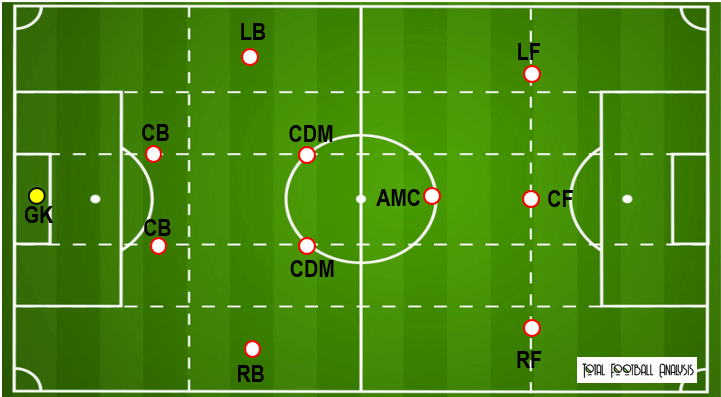
As the above tactical diagram shows, Iraola’s preferred formation was a 4-2-3-1 which they used from the start of the season. His side dominated the ball in most of their matches. Their average possession throughout the season of 50.63% while, although impressive for a team who entered most matches as underdogs, it does not tell the whole story.
This average would be a lot higher if matches against Barcelona and Real Madrid were taken out. For example, in their most recent match against Barcelona, having scored the match’s only goal in the sixth minute, Rayo went on to have just 29.37% of the ball.
Rayo slightly underperformed their xG of 1.3 over the 38 games, scoring an average of 1.03 goals per 90 minutes. They finished 11th in the expected points table, one position above their actual position, with an expected points tally of 51.8. Their actual 42 points haul suggests they underperformed their points total by 9.8. Underperforming in their xG and expected points indicates their survival in La Liga was not down to luck and, if anything, they should have finished higher up.
Centre forward, number ‘16’ Sergi Guardiola, on loan from Real Valladolid, ended the season as the top scorer at the club with eight goals. Just behind him, having played 919 minutes less, was number ‘3’ Radamel Falcao with six. Falcao, one of the few players in the squad with La Liga experience, had a chance conversion rate of 35%– 1% higher than La Liga’s top scorer Karim Benzema.
Switches of play
Rayo Vallecano use switches of play to great effect and have created several goals in their last 10 matches of the season using this method. These plays involve creating one on one or two on two situations on the far side of the pitch. How they created these situations and how they moved the ball there varied.
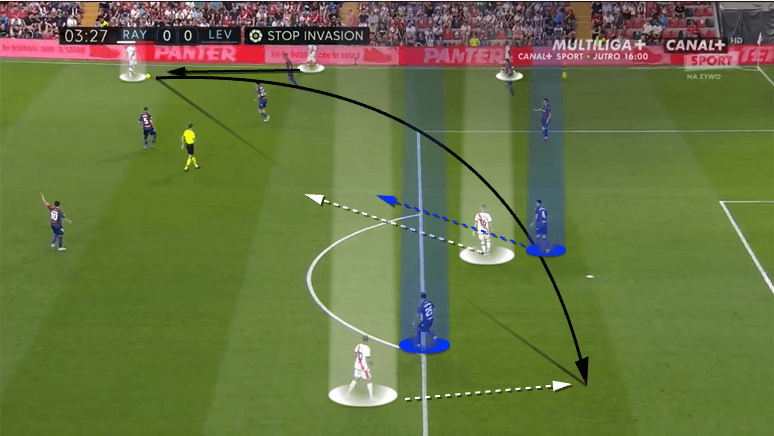
During sustained positional attacks, Rayo often overload the ball side of the pitch when they have possession in the wide areas. This usually involves the wide-forwards and full-backs, plus the DMC and/or AMC.
On the other side of the pitch, the centre-forward will occupy the ball far centre-back and the opposite wide-forward occupy the full-back. This creates a two-on-two situation where Rayo want to switch the ball to. Often, Rayo’s centre forwards’ movement will then isolate their wide-forward one-on-one with the full-back.
The image above shows the moments before Rayo switch/cross the ball from their left side to their right-forward who is in the box. They have three players highlighted in the wide area, plus another one just out of shot, who attracted the opposition into that area.
The ball-near centre-back had been dragged over to the right of the box to cover his right-back. This created a two-on-two on the opposition’s left side. Just as the ball was about to be switched/crossed, the centre-forward, Guardiola, made a diagonal run towards the ball. This left his right-forward one-on-one at the back post. On this occasion, the ball was delivered to the right-forward, beyond the left-back giving the forward a clear shot at goal.
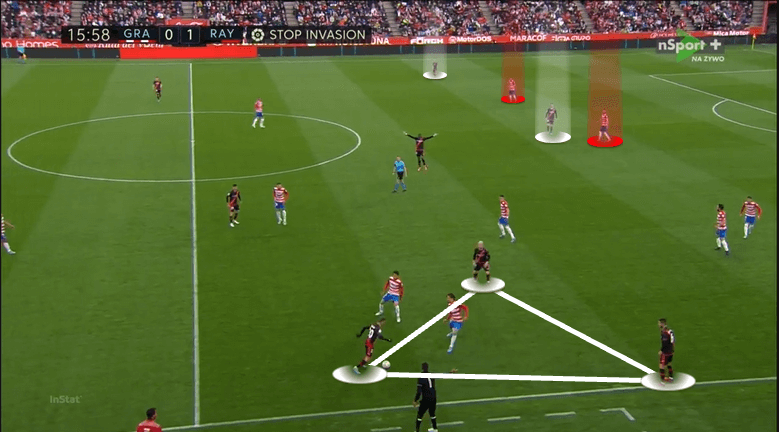
In this situation, the right-back, right-forward and DMC, who had pulled all the way out to the touchline, created a triangle in the wide area. The left-forward and Guardiola stayed away from the ball and occupied the ball-far centre-back and the right-back. With the opposition drawn towards the ball, the two ball-far forwards have isolated the two defenders.
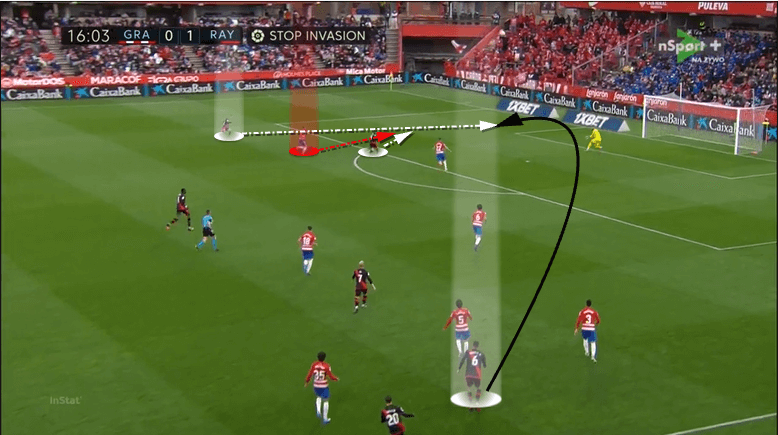
From their triangle, Rayo created enough space for the DMC, number ‘6’ Santi Comesaña, to open his body and cross the ball. When the ball was in the air, Guardiola deliberately stepped across the opposition right-back’s path. This blocked the right-back, preventing him from tracking the left-forward, number ‘18’ Alvaro Garcia.
This allowed Garcia to receive the ball unimpeded in the assist zone. He then combined with Guardiola who finished well to fore Rayo into a two-goal lead.
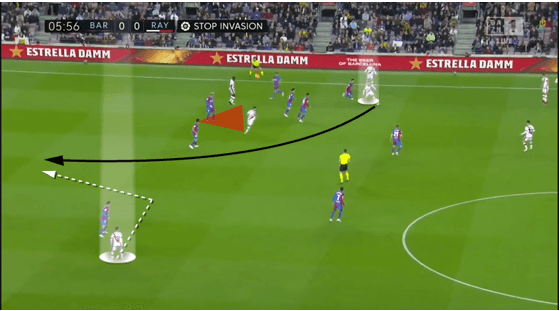
This image, from Rayo’s victory in the Camp Nou, again shows Iraola’s men overloading one side of the pitch. This attracted seven Barcelona players who are surrounding the ball.
Guardiola, on this occasion, is closer to the ball but is still occupying the ball-far centre-back. Garcia, has again, kept his width on the left side. This positioning has created a gap between the opposition’s left-back and centre-back.
When right-forward, number ‘7’ Isi Palazón, emerged from the tight area with the ball on his preferred left foot, Garcia made a run across the left-back. He then cut in behind as Palazón played a line-breaking pass. Garcia ran onto the through ball to score what would turn out to be the winning goal.
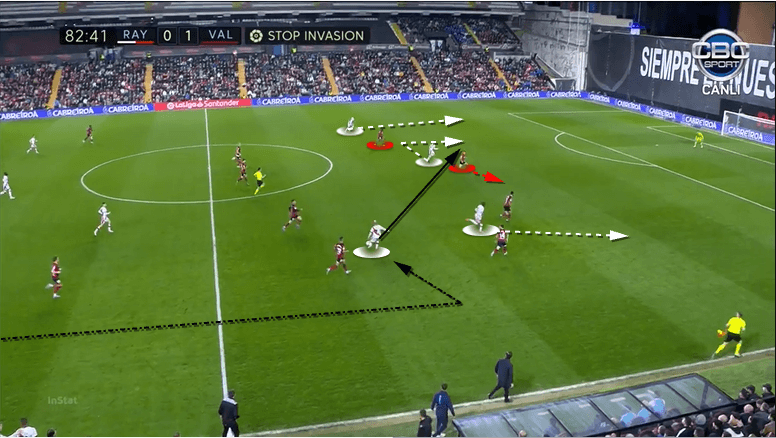
In this scenario, Rayo have launched a counterattack that began at the edge of their own box on the right side. Palazón received the ball in his own third and progressed with it until he was engaged by the opposition left-back.
Palazón ran at the left-back before cutting inside, opening up the whole pitch. Even from counterattacks, the aim of isolating the ball-far centre-back and full-back remains the same.
As Palazón drifted inside with the ball, his AMC made a run between the left-back and ball-near centre-back. This meant the ball-far centre-back had to shift over to cover his defensive partner.
Garcia, on the far left of the pitch, made a forward run whilst keeping his width. This maintained the space between the opposition’s right-back and ball-far centre-back that had been created by the AMC’s run. Palazón played a key pass through this gap for Guardiola. The striker opened his body up to let the ball roll across him before striking the ball first time past the opposition goalkeeper.
Pressing goal kicks
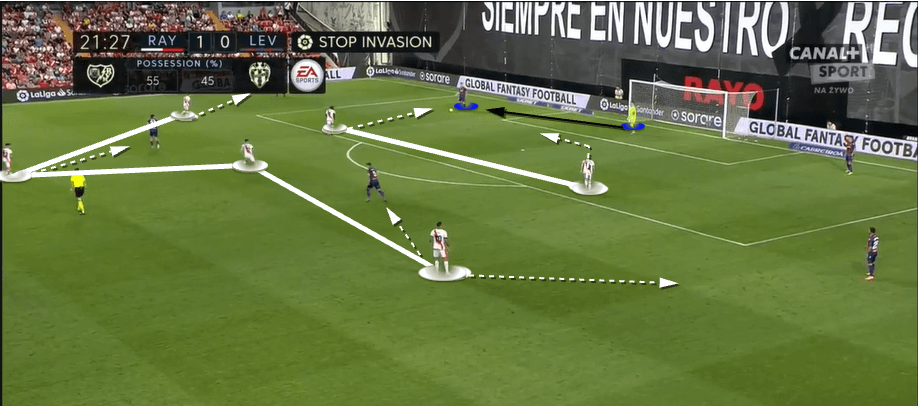
This section is going to analyse Rayo’s aggressive high press on opposition goal kicks in their end-of-season matches against Levante and Villareal. As the above image shows, Rayo press in what is almost a 4-4-2 with their two forwards positioned on the edge of the box in-line with the centre-backs.
When the ball is passed to one centre-back, the nearest forward presses in a straight line cutting off forward passes. The other forward prevents the ball from being switched back across the box by making a looping run. The wide midfielders, who are initially positioned in relation to the opposition full-backs, press the nearest full-back if he receives the ball. The ball-far midfielder tucks in beside his central midfielders.
The aim of the press appears to be to overload one side of the pitch, prevent a switch of play and then either steal the ball or force the opposition to play long. Due to the speed and organisation of the press, as with the above example, this usually works well. However, as the following two examples show, Levante and Villarreal both found solutions to overcome the press.
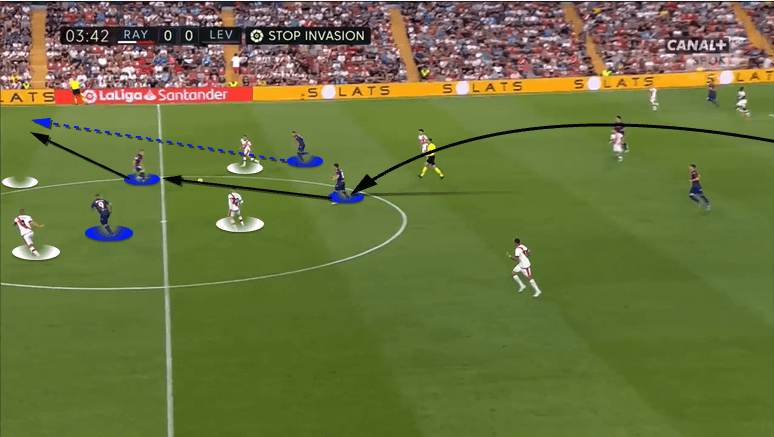
When the opposition’s front players drop in between Rayo’s backline and midfield, Rayo’s back four aggressively track these players. They will tightly mark them even if this pulls the back four out of shape.
The above image shows the moments after a goal kick when Levante’s goalkeeper received the ball back from his centre-back and played long. Levante’s two wide midfielders have both moved inside the pitch, between the lines, creating a 4-2-2-2 shape. Both of Rayo’s full-backs have followed them inside.
When Rayo’s left-midfielder received the long ball, he flicked it on to one of his forwards who had moved towards the ball. As this was happening, the right-midfielder made a blind side run into the wide area. The forward then played in the midfielder down the side of the centre-back to create a dangerous opportunity.
Usually, Rayo were able to win the aerial duals whenever Levante went long, however, this was a clear demonstration of the risk of leaving such gaps when pressing.
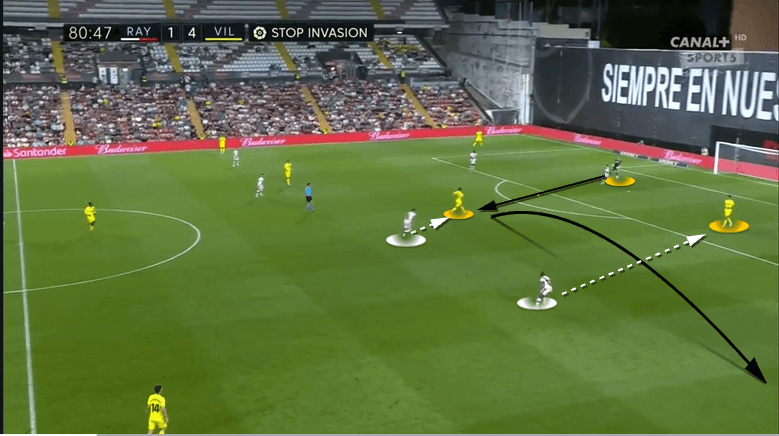
Unlike Levante, Villarreal were not willing to go long in the build-up. The Champions League semi-finalists quality, in a match they won 5-1, meant, on some occasions, they were able to pass their way through the press.
Villarreal complicated Rayo’s press by having a centre-back take the goal kick from the side of the 6-yard box and pass to his goalkeeper. Rayo’s forward still positioned himself in line with the centre-back, meaning he had longer to travel to press the ball. As in the above scenario, the goalkeeper had time to get his head up and find a pass to his DMC.
When the DMC received the ball, whilst being pressed by Rayo’s central midfielder, he took a touch with his right foot towards his left centre-back. Rayo’s right midfielder’s reaction was to press the centre-back. The DMC then calmly played a pass with his left foot behind the pressing midfielder to his left-back. Villarreal’s left midfielder, number ‘14’ pinned Rayo’s right-back (out of shot), allowing his left-back to proceed with the ball deep into Rayo’s half.
Conclusion
Although results petered out towards the end of the season, Iraola, who is working with the fourth-lowest budget in the league, must be delighted with this season’s work. Their results, xG and tactically astute style of play show they deserve the praise and league position they achieved this season.
With the sixth youngest team in the league and a full season of experience in the top flight, the future is bright for Iraola and Rayo Vallecano.






Comments